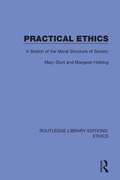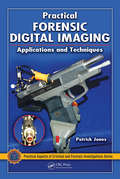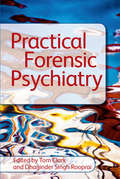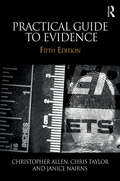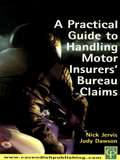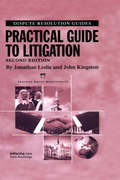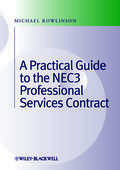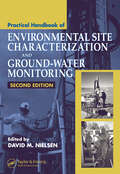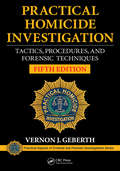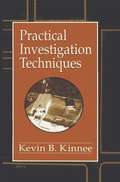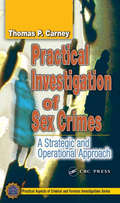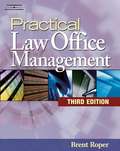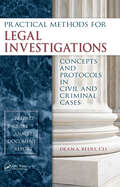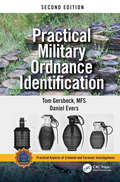- Table View
- List View
Practical Ethics for the Surgeon
by Lloyd JacobsPublisher's Note: Products purchased from 3rd Party sellers are not guaranteed by the Publisher for quality, authenticity, or access to any online entitlements included with the product. Recent, significant changes in surgery, technology, regulations, and society have greatly impacted how surgeons consider ethical issues in light of professional expertise, wisdom, and personal responsibility. Dr. Lloyd A. Jacobs, along with world-renowned surgeons and other health care professionals, provides thoughtful, intellectually challenging information and commentary in an easy-to-understand manner to help surgeons think through and respond effectively to complex questions of life, death, provision of health care, and more. Covering the wide range of ethical concerns facing today’s surgeons, this concise, readable title is beneficial at all levels of training and practice.
Practical Ethics: A Sketch of the Moral Structure of Society
by Mary Sturt Margaret HoblingOriginally published in 1949, this book covers both psychological and sociological aspects of moral life in Western society in the first half of the 20th Century and the historical influences on its thinking and way of behaviour. It discusses education, art, social structure, law and religion and ethical failure.
Practical Fairness: Achieving Fair And Secure Data Models
by Aileen NielsenFairness is an increasingly important topic as machine learning and AI more generally take over the world. While this is an active area of research, many realistic best practices are emerging at all steps along the data pipeline, from data selection and preprocessing to blackbox model audits. This book will guide you through the technical, legal, and ethical aspects of making your code fair and secure while highlighting cutting edge academic research and ongoing legal developments related to fairness and algorithms.There is mounting evidence that the widespread deployment of machine learning and artificial intelligence in business and government is reproducing the same biases we are trying to fight in the real world. For this reason, fairness is an increasingly important consideration for the data scientist. Yet discussions of what fairness means in terms of actual code are few and far between. This code will show you how to code fairly as well as cover basic concerns related to data security and privacy from a fairness perspective.
Practical Fire and Arson Investigation (ISSN)
by David R. Redsicker John J. O'ConnorDid you know. . .. . . that arson has been described as the fastest-growing crime in America?. . . that arson is the most expensive crime committed?. . . that over 8 billion dollars was estimated lost due to fires in 1994?. . . that an estimated 86,000 structure fires of incendiary or suspicious origin were reported in 1994?Davi
Practical Forensic Digital Imaging: Applications and Techniques (ISSN)
by Patrick JonesWell-documented scenes can prove to be invaluable pieces of evidence at trial, and the ability to take compelling photographs is a critical skill for forensic scientists and investigators. Practical Forensic Digital Imaging: Applications and Techniques is an up-to-date and thorough treatment of digital imaging in the forensic sciences. Balancing pr
Practical Forensic Microscopy: A Laboratory Manual
by Barbara P. WheelerAn applied approach to teaching forensic microscopy in educational settings, featuring new experiments and an up-to-date overview of the field Practical Forensic Microscopy: A Laboratory Manual, 2nd Edition, is a unique resource that brings the microscopic procedures used by real-world forensic investigators to the college laboratory, providing hands-on knowledge of the microscopes and microscopic techniques used in the field. Presenting a balanced, skills-based approach to the subject, this student-friendly lab manual contains dozens of experiments designed to cover the various microscopic evidence disciplines, including examinations of fingerprints, firearm, toolmark, shoeprint and tire impressions, gunshots, fibers, soil, glass breakage, drugs, semen, and human hair. The second edition includes revised and updated experiments that reflect current technologies and techniques used in forensic science, including new experiments examining plastic film, food condiments, feathers, building materials, explosive residue, cigarette butts and more. Each chapter includes a list of simple objectives for the experiment, a general overview of the topic, further readings, and selected references. The manual contains worksheets and templates for students to use when compiling analytical results. The concluding chapter features an innovative case scenario that requires students to analyze items of evidence, complete a laboratory report, reach a conclusion, and present their findings. This popular lab manual: Teaches practical forensic microscopy skills through hands-on experiments and engaging practical activities Covers a wide range of microscopes and forensic tools, including stereomicroscopes, ocular micrometers, and fluorescence, polarized light, and phase contrast microscopes Explains simple stereomicroscopic techniques for analyzing various types of common forensic evidence Includes more complex procedures for examining biological, drug, and trace evidence Discusses laboratory safety, microscope maintenance, and the Micro Kit Written by an author with years of academic and professional experience, Practical Forensic Microscopy: A Laboratory Manual, 2nd Edition, is a must-have companion for any college-level forensic science course with a laboratory component, and is a useful supplement for related courses that cover microscopy and the principles of forensic lab procedures.
Practical Forensic Pathology and Toxicology
by Robert H. Powers Dorothy E. DeanPractical Forensic Pathology and Toxicology is a companion to the authors’ original book on the subject, Forensic Toxicology: Mechanisms and Pathology. This new volume addresses issues that forensic pathologists face when confronted by the suspected or demonstrated presence of drugs or toxins in their cases. Since such considerations include the need for a basic understanding of the direct physiological effects of potentially toxic agents, the authors highlight various connections and interaction between forensic pathology and toxicology. The book is written for both the practicing pathologist, and those in training, who may already have some knowledge of forensic medicine but are on occasion faced with issues that reach beyond a basic determination of cause and manner of death.Pathologists are expected to provide informed, well‑reasoned opinions explaining how a person died—which includes questions about any drugs, prescription medications, or otherwise that may have caused or contributed to death. As such, this book looks at the direct physiological effects of drugs and toxins, answering questions such as “Why does hypernatremia cause seizures?” or “Why can synthetic cannabinoids cause fatal complications, yet THC does not?” or the very timely “What is the mechanism by which an opiate overdose causes death?” Coverage primarily centers on the pathological derangements and physiological consequences of the actions of drugs and toxins, and the cellular mechanisms by which those pathological consequences arise.Organized using an organ system approach, sections are divided into major target organ systems and sections included for affected organs and tissues. While some drugs affect more than one organ system—and some patients will have multiple drugs present—the book’s categorization and organization take this approach to be readily usable for the reader. Case reports are included with additional patient data to show the effects of specific toxins and poisons both alone and in combination with natural disease. Color figures illustrate all aspects of drug or toxin impact on postmortem casework including the scene of death, the deceased persons, and the organs and tissues affected.Practical Forensic Pathology and Toxicology is an invaluable resource for practicing pathologists, toxicologists, and those training for those fields. It also serves as a useful reference for lawyers, judges, insurance companies, and other medical professionals who need to know, in light of what drugs are present in a particular case, what such compounds do, and how their presence (or absence thereof) is—or is not—related to an individual’s death.
Practical Forensic Psychiatry
by Tom Clark Dharjinder Singh RoopraiSuccinct, structured, and focused, this book concentrates on the key facts and practical day-to-day issues vital to forensic psychiatry.Includes fact-oriented practical advice and clinically relevant examples Reflects current practice and the latest laws Provides tips on testifying in legal mattersFeatures a clear bullet point style to help readers
Practical Guide to Evidence
by Chris Taylor Christopher Allen Janice NairnsPractical Guide to Evidence provides a clear and readable account of the law of evidence, acknowledging the importance of arguments about facts and principles as well as rules. This fifth edition has been revised and updated to address recent changes in the law and debates on controversial topics such as surveillance and human rights. Coverage of expert evidence has also been expanded to include forensic evidence, bringing the text right up-to-date. Including enhanced pedagogical support such as chapter summaries, further reading advice and self-test exercises, this leading textbook can be used on both undergraduate and professional courses.
Practical Guide to Handling Motor Insurers' Bureau Claims
by Nick Jervis Judy DawsonThe 1999 Uninsured Drivers Agreement applies to accidents in which an uninsured driver was involved, which have occurred after 1 October 1999. Limitation periods for cases under the agreement will start to expire from 1 October 2002, after which procedural defects cannot be overcome by discontinuing and reissuing. To avoid satisfying any unpaid judgments, the Motor Insurers Bureau (MIB) will be able to act on any failure by claimants solicitors to comply with the strict terms of the Agreement. In order to prepare for this, those dealing with Motor Insurers Bureau claims must have watertight systems in place in order to avoid potential negligence claims. This book is an essential guide to preparing such procedures, and includes a series of standard letters, checklists and diary entries to guide a practitioner through each aspect of such a claim.The guide deals with the detailed provisions of the 1999 Agreement and the Revised Notes for Guidance (2002 ). The difficult tasks of handling claims against uninsured drivers and dealing with the MIB are addressed in a practical manner. All relevant recent legislation is discussed, as well as claims against untraced drivers and methods of discovering road traffic insurers to prevent the necessity of involving the MIB. Guidance is also given regarding setting up a department to deal with MIB claims. The book will be indispensable for any legal executive or solicitor dealing with MIB claims, particularly those handling road accident personal injury claims and all those managing teams of injury specialists. To effectively handle Motor Insurers' Bureau claims, the letters and checklists in this book are essential. To save you time, all the documents (letters, checklists, questionnaires and forms) contained in the book are available as Word documents for a fee of 10. The complete package can be sent to you by email or on disk by post.
Practical Guide to Litigation
by John Kingston Jonathan LeslieAgainst the background of Lord Woolf's interim report "Access to Justice", this text includes accounts of tactical matters and practical litigation "tips", as well as descriptions of the procedures involved. Litigation is often conducted by companies who do not have much practical experience of the processes that might be expected of them. The same applies to others who become involved in litigation without actually having to conduct the procudure as lawyers. This book is intended to give a brief, clear and comprehensive overview of litigation, arbitration and ADR in England. Intended as a comprehensive overview of litigation, arbitration and ADR in England, this guide is aimed at clients and firms who are involved in, or assist cases, who would like to understand the process better in a non-technical way but do not want to see every statement supported by authority.
Practical Guide to Schengen Law (SpringerBriefs in Law)
by Fabian LutzSchengen law is legally complex and, at the same time, foundational for the free movement objectives of the European Union. This "Practical Guide to Schengen Law" seeks to explain the specific features of Schengen law and its differences from normal EU law. It focuses on the territorial scope of application of Schengen law (variable geometry) and on the determination of the substantive scope of the Schengen acquis. It also includes replies to frequently encountered practical questions arising in that field.In addition to its descriptive function, this guide also aims at closing a gap in the scholarly analysis of Schengen. The substance of the Schengen acquis has already been subject of numerous publications, with specific emphasis on: border controls, security and human rights, institutional balance and implementation. However, there has been little scholarly attention to the challenges resulting from the application of the legal criteria, introduced in 1999, for distinguishing Schengen-related developments of the EU law from the broader Justice and Home Affairs EU law and the resulting legal and political problems.
Practical Guide to the NEC3 Engineering and Construction Contract
by Michael RowlinsonLaunched in 1993, the NEC Engineering and Construction Contract has become one of the UK s leading standard forms of contract for major construction and civil engineering projects. The third edition, popularly known as NEC3, is a process based contract embodying project and commercial management best practice, so its basic philosophy differs from the more adversarial approach of other standard construction contracts. Since the first edition of this book, the third edition of the contract has seen the introduction of a new secondary option for use in the UK and amendments to a number of clauses. In addition, in September 2011, changes were introduced to cater for the amendments to the Housing Grants, Construction and Regeneration Act 1996 contained in the Local Democracy, Economic Development and Construction Act 2009, which became effective for all new contracts entered into from 1 October 2011. These amendments have been incorporated into the text. A Practical Guide to the NEC3 Engineering and Construction Contract will be useful to everyone in the construction industry working on a project under this contract. It will be of interest to the complete construction supply chain, including employers, construction professions, contractors and sub-contractors, as well as consultants and lawyers advising any of these parties, either in the preparation of contract documentation or the day to day management or the resolution of problem situations which may arise.
Practical Guide to the NEC3 Professional Services Contract
by Michael RowlinsonCurrently in its third edition, the NEC suite has become one of the UK's leading families of standard forms of contract for major construction and civil engineering projects. Part of the NEC suite, the Professional Services Contract (PSC) was drafted with the same process-based approach and objectives, offering a standard contract for the appointment of consultants providing professional services in an engineering or construction project. Embodying best practice in terms of project management, the basic philosophy of the PSC differs from the principles and approach of other standard contracts used to appoint consultants.This book is a practical guide to the application of the PSC. Starting with a brief discussion of the background and philosophy behind the PSC, it identifies the roles and responsibilities of each of the named functions within the contract, explains the approaches required to achieve a successful working relationship between all parties, and examines all the procedures in the PSC. The book explains the links between the various sections of the contract to assist the reader with cross referencing, and covers all the variations created by the Main and Secondary Options. As a very practical guide it will aid users in the transition from their use and understanding of the other standard contracts to the collaborative project management-based approach of the PSC.Written for anyone working in the construction and related industries using the PSC to procure or provide consultancy services in relation to a construction project, it will be of interest to the complete construction supply chain, particularly architects, structural engineers, services (M&E) engineers, civil engineers, quantity surveyors and interior designers, together with Contractors and Sub-Contractors who have a design liability and employ consultants to assist them. It will also be of interest to consultants and lawyers advising any of these parties, either in the preparation of contract documentation or the resolution of problem situations which may arise.
Practical Handbook for Professional Investigators
by Rory J. McMahon CLI CFE Randy DicksonThe third edition of this popular volume continues to supply an up-to-date, nuts-and-bolts learning tool for students and an everyday reference for investigative professionals at all levels. More relevant than ever, this edition adds two new chapters on death and terrorism investigations and several new sections, including insurance fraud, fire and arson investigation; indicators of online marital infidelity; obtaining governmental reports; service of subpoenas for witnesses in federal courts; the Rules of Professional Conduct; niche markets in the investigative industry; and managing and marketing an investigative practice.
Practical Handbook of Environmental Site Characterization and Ground-Water Monitoring
by David M. NielsenPublished in 1991, the first edition of The Practical Handbook of Ground-Water Monitoring quickly became the gold standard reference on the topic of ground-water monitoring. But, as in all rapidly evolving fields, regulations change, technology advances, methods improve, and research reveals flaws in prior thinking. As a consequence, books t
Practical Homicide Investigation Checklist and Field Guide (ISSN)
by Drummer Steven B. Vernon J. Geberth Karch Olaf Ffflm Md Steven B.This book provides protocols for suicide and equivocal death investigation, police action shooting investigations and a homicide supervisor's checklist. It contains state-of-the-art anatomical graphics in full color to assist the investigator in describing any injuries or wounds to the body.
Practical Homicide Investigation: Tactics, Procedures, and Forensic Techniques, Fifth Edition (Practical Aspects of Criminal and Forensic Investigations)
by Vernon J. GeberthRenowned for being THE definitive resource for homicide investigators, Practical Homicide Investigation: Tactics, Procedures, and Forensic Techniques details the recognized protocols used by investigative divisions of major police departments throughout the world. The text is used in most police academies, including the FBI Academy in Quantico, Virginia.Now in its fifth edition, the book begins with a comprehensive discussion of homicide crime scenes and moves chronologically from initial police notification, the correct police response that follows, and the subsequent steps necessary to conduct an intelligent investigation. It then delves into the more technical aspects of homicide investigation, augmented with numerous pictures and full-color illustrations that involve pertinent case histories.This latest edition includes three new chapters along with fully revised chapters with new case histories and techniques that reflect the latest forensic methods and modern investigative procedures.Highlights of the Fifth Edition Include: Newly revised "Homicide Investigator’s Checklist" A new chapter on the latest DNA technology A rewritten chapter on equivocal death investigations that includes staged crime scenes Additional information on modes of death Fully updated chapters on death notifications, sex-related homicide, management for police administrators, suicide investigation, and narcotics-related and homosexually based homicides Over 920 photos and illustrations, 250 new photographs, and several new case histories Eminent author, lecturer, consultant, and expert witness Vernon J. Geberth incorporates his more than four and a half decades of real-world law enforcement experience in this quintessential reference. This classic and must-have resource provides the most vital information needed by detectives and police investigators responsible for cases in violent and sudden death. Remember: do it right the first time. You only get one chance.—Vernon J. Geberth, M.S., M.P.S., Homicide and Forensic Consultant, Author of Practical Homicide Investigation, and Series Editor of The Practical Aspects of Criminal and Forensic Investigations
Practical Investigation Techniques (Practical Aspects Of Criminal And Forensic Investigations Ser. #11)
by Vernon J. Geberth Kevin B. KinneePractical Investigation Techniques is useful for new as well as veteran investigators to establish a practical standard for conducting a wide range of diverse criminal investigations. Written by a veteran investigator, the book teaches the proper investigative techniques for such criminal activities as extortion, blackmail, credit card fraud, check fraud, fencing operations, employee theft, sports gambling, money laundering, and shoplifting rings. Practical Investigation Techniques is presented in an easy-to-read format and provides a wealth of specific investigation techniques, checklists, and case studies.
Practical Investigation of Sex Crimes: A Strategic and Operational Approach (ISSN)
by Thomas P. CarneyBecause of the sensitive nature of sex crimes, police officials must develop a specialized set of interviewing skills to effectively investigate them. Written by former Commanding Officer of the Manhattan Special Victims Squad Thomas P. Carney, Practical Investigation of Sex Crimes: A Strategic and Operational Approach provides a day-to-day guide f
Practical Law Office Management (3rd Edition)
by Brent RoperPractical Law Office Management, third edition focuses on law office management from a practical standpoint. Designed for the paralegal student interested in day-to-day law office management topics, this text focuses on client relations and communication skills; legal fees, timekeeping, and billing, client trust funds and law office accounting; calendaring, docket control, and case management; legal marketing; and file and law library management. This revised edition offers an extended focus on technology, including a full demonstration of Thomson's ProLaw software and in-depth software tutorials. It includes up-to-date charts and graphs that present material in an easy-to-understand context. Each chapter now includes thought-provoking questions, and expanded and interesting case studies that deal with unique facts specific to practicing paralegals appear after most chapters. To expand the technology focus of the text, Excel exercises appear in the timekeeping and billing and trust account chapters. In addition, this revised text has a strong ethics focus throughout, with ethics-related cases included at the end of nearly every chapter.
Practical Management of Research Animal Care and Use Programs: Questions and Answers (Laboratory Animal Science and Medicine #3)
by Javier Guillén Viola GalligioniThis book provides a complete guide to all the aspects to consider during planning, establishing and managing ethically and efficiently research animal care and use programs, taking into account all stakeholders involved in the process. Practical information on how to address the general and particular needs of all animal care and use program areas is provided. Consequently, the reader is supported with getting their project ethically and legally compliant, and implemented efficiently with organizing safe and appropriate facilities and equipment as well as hiring sufficiently trained personnel. Furthermore, strategies for impactful internal and external communication are outlined. Responsible use of animals in research can be nothing but teamwork. The environment and professional experience of all involved stakeholders are the key for ensuring quality science, as well as animal and personnel welfare. Research animal care and use programs represent a complex system in which animals, legislation and good practices, facility personnel and researchers interact on a daily basis. Thoughtful planning from the first step ensures animal welfare and improves the quality of in vivo experimentation. This book addresses animal program managers, veterinarians, researchers and technicians working in research animal facilities. Chapter 18 is available open access under a Creative Commons Attribution 4.0 International License via link.springer.com.
Practical Methods for Legal Investigations: Concepts and Protocols in Civil and Criminal Cases
by CLI, Dean BeersLegal investigators are responsible for providing factual evidence � as the fact finders, they are the foundation for the attorneys they work with daily. The attorney is responsible for forming and implementing the legal strategy and presenting it to the judge or jury. The legal investigator provides checks and balances to ensure that no evidence i
Practical Military Ordnance Identification, Second Edition (Practical Aspects of Criminal and Forensic Investigations)
by Thomas GersbeckThe threat variables associated with military ordnance are enormous, requiring the application of a structured process to identify unknown munitions. The focus of Practical Military Ordnance Identification, Second Edition is the application of a practical deductive process to identify unknown ordnance items that are commonly recovered outside military control. The author supplies a seven-step procedure to identify unknown munitions by their category, group, and type. Detailed logic trees help users narrow down the possibilities in order to accurately identify ordnance. The book covers the safety precautions associated with each category and group of ordnance. It describes many ordnance construction characteristics and explains the fundamentals of military ordnance fuzing. Appendices define terms and supply abbreviations and acronyms used to describe military ordnances. Coverage new to this edition include: a list of conventional markings; additional safety precautions to take; an expanded list of high explosives; additional technical details on explosives effects; hazards associated with pyrotechnics, pyrophorics, smoke compounds, and incendiaries; a section on pre-1870 projectiles, hand grenades, landmines, underwater ordnances, and rockets; and details on Man-Portable-Air-Defense-Systems (MANPADS) missile systems.
Practical Mobile Forensics
by Rohit Tamma Heather Mahalik Satish BommisettyThe book is an easy-to-follow guide with clear instructions on various mobile forensic techniques. The chapters and the topics within are structured for a smooth learning curve, which will swiftly empower you to master mobile forensics. If you are a budding forensic analyst, consultant, engineer, or a forensic professional wanting to expand your skillset, this is the book for you. The book will also be beneficial to those with an interest in mobile forensics or wanting to find data lost on mobile devices. It will be helpful to be familiar with forensics in general but no prior experience is required to follow this book.

